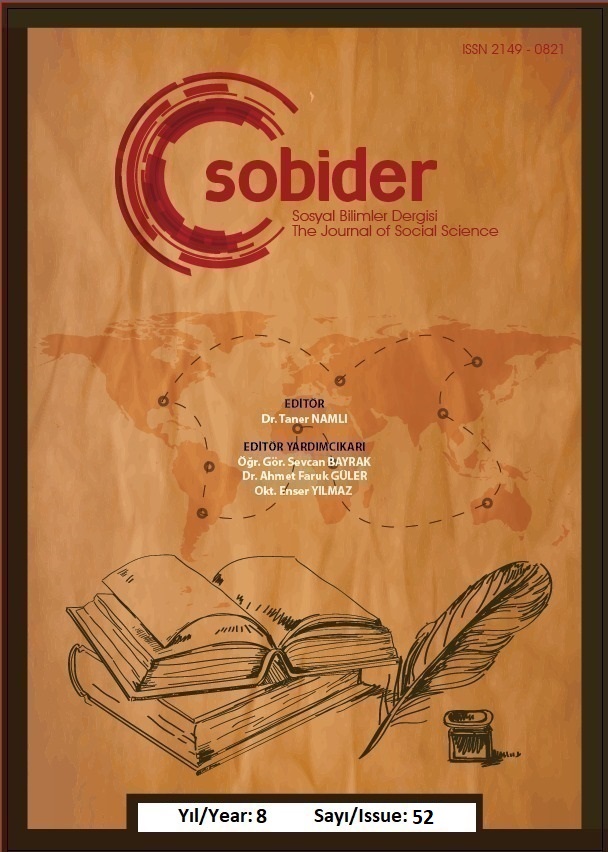Author :
Abstract
Boşluk, sanat tarihinde geniş bir kullanıma sahip olan bir temsil aracıdır. Sanat ve tasarım alanında boşluğun kullanımı, algı üstündeki etkisi ve kuramsal perspektiflerinin yanı sıra bir mekân üretimi, kültürel ve felsefi envanteri ortaya çıkarmaktadır. Boşluk bazen sanat eserinde görünen şeye, bazen de görünmeyen, tamamlayıcı bir öğeye karşılık gelmektedir. Boşluk, görünmeyeni en az görünen kadar açığa çıkarması bakımından önemlidir; çağdaş sanatta boşluk üretimi, sanatçının kendi üzerine düşünme pratiği ve kendi konumunu sorguladığı bir hareket olarak öne çıkmaktadır. Çağdaş sanatta boşluk kavramı, sanatçının modern temsil arayışında kurumsal eleştiriyi ve sanatçının özgür ifade olanaklarını ortaya çıkarmaktadır. Bu bakımdan boşluk, çağdaş sanat alanında temsil kavramının bir parçasını oluşturmaktadır. Boşluk kavramı, sanatsal deneyimin bir öznesinin oluşturulması, sanatsal üretimin koşullarını belirleyen ve bu üretimin ortaya çıkması üzerinde denetim kuran çerçevenin sorunsallaşmasıyla ilişkili olarak da kendini sorunsallaştırmaktadır. Makale kapsamında, çağdaş sanatın ana problematiklerinden biri olan temsil kavramı, sanatın ve sanat üretiminin özerkliği, kurumların ve piyasa kurallarının gücü karşısında ‘görünmezin üretimi’ boşluk metaforu etrafında incelenmektedir. Boşluk kavramının kültürel envanteri ve evreni şekillendirmekteki gücü, düşünsel ve tarihsel arka planı tartışmaya açılarak çok katmanlı bir alanda var olması amaçlanmaktadır.
Keywords
Abstract
The void is a means of representation that has wide use in art history. The use of space in the field of art and design reveals a space production, cultural and philosophical inventory as well as its effect on perception and theoretical perspectives. The void sometimes refers to what appears in the work of art, and sometimes to an invisible, complementary element. Space is important in that it reveals the invisible at least as much as the visible; The production of space in contemporary art stands out as a movement where the artist questions the practice of thinking on himself and his position. The concept of emptiness in contemporary art reveals the institutional criticism and the free expression possibilities of the artist in the search for modern representation. In this respect, emptiness constitutes a part of the concept of representation in the field of contemporary art. The concept of emptiness also problematizes itself about the creation of a subject of artistic experience, the problematization of the framework that determines the conditions of artistic production and establishes control over the emergence of this production. Within the scope of the article, the concept of representation, which is one of the main problematics of contemporary art, the autonomy of art and art production, the power of institutions and market rules, is examined around the metaphor of "the production of the invisible" space. The cultural inventory and the power of the concept of void in shaping the universe and its intellectual historical background are discussed and the discussion is aimed to exist in a multi-layered area.
Keywords
- Achino-Loeb, A. M. (2005). “Silence: The Currency of Power”, Berghahn Books.
- Atış, Naciye. (2012). Parmenides Felsefesinin Varlığı Temellendirme Tarzının Kendinden Sonraki Felsefeye Etkileri. Felsefe ve Sosyal Bilimler Dergisi. Erişim Tarihi: 04.04.2021. https://dergipark.org.tr/en/download/article-file/803662.
- Bhabha, Homi K. (1998). Anish Kapoor Making Emptiness by Homi K. Bhabha Interiew Anish Kapoor and Homi K. Bhabha http://anishkapoor.com/185/making-emptiness-by-homik-bhabha, Erişim Tarihi: 12.03.2021.
- Benjamin, H.D. Buchloh. (2006). “Gabriel Orozco: Sculpture as Recollection,” in Gabriel Orozco, Mexico City, Mexico: Museo del Palacio de Bellas Artes.
- Cage, John. (1990). I-VI. Published by Cambridge & London: Harvard University Press.
- Cheng, François. (2006). Boşluk ve Doluluk-Çin Resim Sanatının Anlatım Biçimleri, Çev. Kaya Özsezgin, İmge Yayınları.
- Dere, Mehmet. (2016). Taryn Simon Bağlamında Günümüz Sanatında Etkin Olan Direniş Politikaları, Yüksek Lisans Tez Metni, (D.E.Ü).
- Demos, J. (2001). “Duchamp’s Labyrinth: First Papers of Surrealism, 1942”, October, 97, (Yaz 2001), s. 91-119).
- Gironi, Fabio. (2012), “Śūnyatā and the Zeroing of Being: A reworking of empty concepts”, Journal of Indian Philosophy and Religion, 15: 1-42.
- Goy, Bernard. (1990), “Interview with Marina Abramović”, Journal of Contemporary Art, June. http://www.jca-online.com/Abramovic.html, Erişim Tarihi: (15.03.2021).
- Grandy, David. (2016). Sunyata in the West Comparative Philosophy Volume 7, No. 1 39-58, www.comparativephilosophy.org, https://core.ac.uk/download/pdf/70424786.pdf, Erişim Tarihi: (15.03.2021).
- Johan, Wagemans, Gepshtein S., Pomerantz J.R., Feldman J., Kimchi R. (2012), “A Century of Gestalt Psychology in Visual Perception”, Psychological Bulletin.
- Klein, Yves. (2007). The Specialization of Sensibility in the Raw Material State of Stabilized Sensibility - exhibition of "The Void", April 28 - May 12, 1958. void/?of=1, Erişim Tarihi: 05.04.2021.
- Kranz, Walther. (1984). Antik Felsefe, Metinler ve Açıklamalar, Çev. Suad Y. Baydur, Sosyal Yayınlar, İstanbul, B7.8.
- Kuban, Doğan. (2013). Lao Tzu Tao Yolu Öğretisi, İstanbul: Yem Yayınları.
- Leader, Darian. (2004), Mona Lisa Kaçırıdı, Sanatın Bizden Gizledikleri, (çev. Handan Akdemir) İstanbul: Ayrıntı Yayınları.
- O’Doherty, Brian. (2010). Beyaz Küpün İçinde. (Çev. Ahu Antmen). İstanbul: Sel Yayıncılık.
- Pilgrim, Richard. (1986). Intervals ("Ma") in Space and Time: Foundations for a Religio- Aesthetic Paradigm in Japan. History of Religions, 25 (3), 255-277. Retrieved April 14, 2021, from http://www.jstor.org/stable/1062515, Erişim Tarihi: (10.04.2021).
- Platon, Timaios. (2001). (Çeviri, Erol Güney-Lütfi Ay). İstanbul: Sosyal Yayınlar.
- Smart, John Jamieson Carswell. (Ty). One Way View Of Time İn The Philosophy Of History, https://www.britannica.com/science/time/One-way-view-of-time-in-the-philosophy-ofhistory, Erişim tarihi: (01.02.2021).
- Sontag, Susan. (1998), Sanatçı: Örnek Bir Çilekeş. İstanbul: Metis Yayınları.
- Thilly, F., & Wood, L. (1964). A History of Philosophy, Holt Rinehart and Winston Inc,
- Watson, Gay. (2014). A Philosophy of Emptiness, Reaktion Books, Uk, London.
- Y.y., (Ty). White Painting (1951), https://www.rauschenbergfoundation.org/art/galleries/series/white-painting-1951,
